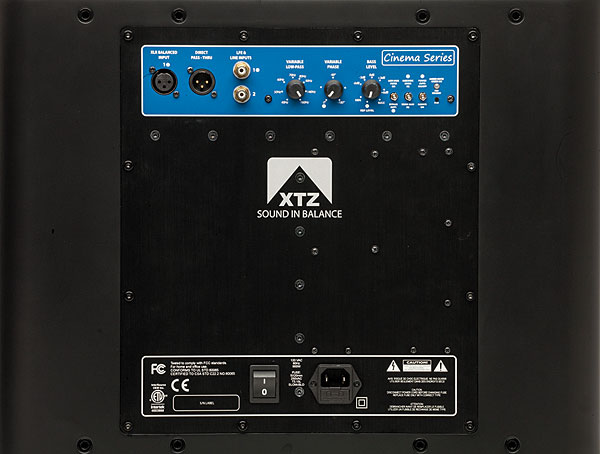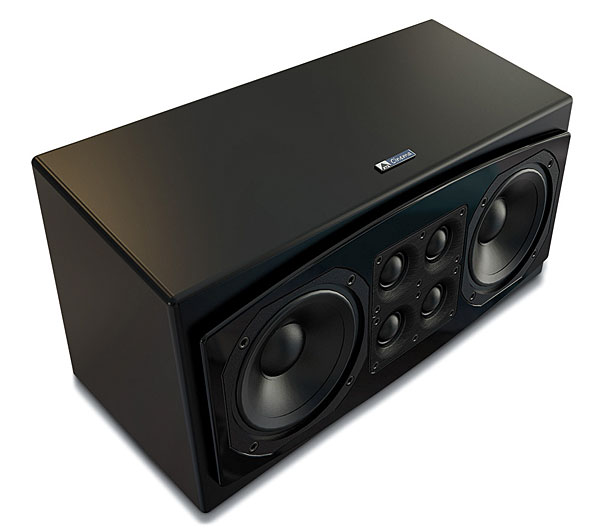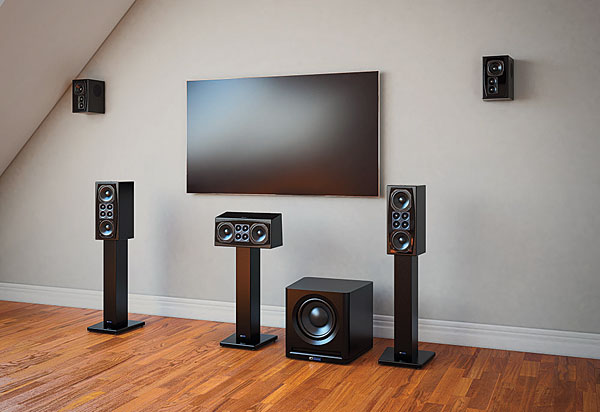XTZ Cinema M6 Speaker System Review Page 2
The stereo imaging of the left and right M6s was tight, but not very deep, as I would expect from an over-/under-woofer design, which tends to focus midrange and treble directivity toward the listener, as does the quad-tweeter array. In fact, off-axis timbre was audibly different at relatively small angles, both vertically and horizontally, at least on a pink-noise track—much more so vertically than horizontally, as is usual from such a layout. (These differences were substantially less obvious on music or speech, of course, but still discernible.)

Given the SUB 1X12’s hulking presence, I couldn’t resist cueing up a few favorite bass cows. The opening of Hall & Oates’ classic “She’s Gone” bloomed with 30-Hz deliciousness, while the finale of the Saint-Saëns Organ Symphony was in-the-hall awesome, and my few, in-the-name-of-science dub-step tracks indeed proved a dentist’s best friend. This is where I put the sub’s EQ switch into play; its Room Gain position was clearly a better choice in my room, keeping the XTZ sub’s abundance of deep bass in better proportion.
Hidden Treasures
It occurred to me that all this might be just what the doctor ordered for a behind-screen setup. And indeed, the M6s—with their sealed, port-
less enclosures and generous wall-hanging options—are obviously designed with such a location in mind. So I lowered my acoustically transparent Seymour RM-80HD4K (I still get a thrill every time I go big-screen), behind which the 8-inch-deep (grille-less) speakers fit handily, and I fired up the projector for the movie-sound phase of my listening.
I’m not usually in favor of taking box speakers and wall-mounting them, but with a THX-standard 80-Hz crossover, the M6s sounded like they were made for it. The wall reinforcement seemed to warm up the midrange just that welcome tiny bit, while the Seymour screen helpfully knocked off just 1 or perhaps 2 decibels from the top octaves. The net result was a very impressive home theater presentation—all the more so because the front-stage speakers were now invisible.

Thus arrayed, the XTZ suite proved extremely able on my familiar rotation of audition movie scenes. All five channels were happy to absorb as much power as I had on offer—150 watts per speaker—without the least evidence of strain or dynamic compression. Dialogue was effortlessly audible and highly intelligible; I suspect that the M6s were voiced from the get-go with film sound in mind, where I find it desirable to have just a touch of emphasis in the presence region as well as tightly controlled directivity.
A recent Blu-ray arrival like Mad Max: Fury Road may set a new high-water mark for ridiculousness, but it served amply to show off the Swedish design’s abilities. At all volumes, the film’s largely guttural (or masked) dialogue remained understandable, and the front stage throughout the (interminably) long chase scenes held together solidly. (As an aside, the horizontal M6 made an acceptable match to the front left and right, but turning the center speaker vertical—and aiming it to compensate for the angled baffle—made a much better match and yielded improved horizontal dispersion for listeners seated off center. This worked fine behind the screen but is likely to be impractical in most glass-screen setups.)
Here, too, setting the SUB 1X12’s EQ switch to Anechoic made Fury Road’s near-continuous low-bass rumblings too prominent and distracting. Toggling it to Room Gain kept the big woofer in scale with the system, at no perceptible sacrifice in deep bass. Which was effectively unlimited: Even at reference level in my substantial-volume studio, the XTZ sub had no problem presenting Max’s most impressive impacts and explosions (of which there are many) with full effect and nary a trace of limiting or overreach. (For those with bigger rooms or stronger constitutions, XTZ offers an incredible $2,499 subwoofer, the SUB 3X12, with three 12-inch drivers and three 500-watt amps in a single 170-pound, nearly 4-foot-high cabinet. Yikes!)

On the surround front, in their default “tripole” mode, the S5 pair performed similarly to good bipole surrounds, with an excellent spread and fairly non-localizable effects. In dipole hookup, they did what I find just about all decent dipoles do, which is what I prefer: present a more involving, less distracting ambience bubble at the cost of less focused and less tonally matched hard-panned effects. It’s a shame that nobody makes a remote-controllable surround speaker that can be switched from dipole to bipole (or, if you will, “tripole”) mode as your content dictates. (I concede the impracticality of making such a speaker, except perhaps in a powered design where electrical switching would be possible. Kickstarter, anyone?)
Conclusion
While I’ve saved it for the end, I did notice that the XTZ setup is, at nearly $5,500, expensive. XTZ sells direct to consumer, though, and with a generous home-trial period, free return shipping, and the Cinema series’ quality of componentry, construction, and performance, there’s value here nonetheless.
Cost aside, XTZ’s Cinema is a very impressive home theater setup. I can’t see recommending it for a music-first layout, but I doubt that most such system-builders would be interested anyway—though this Swedish layout is still a very able music reproducer. For a serious projection room install based on an acoustically transparent screen, a genre that tends to be fairly price-insensitive anyway, I think this system is just about ideal.




























































